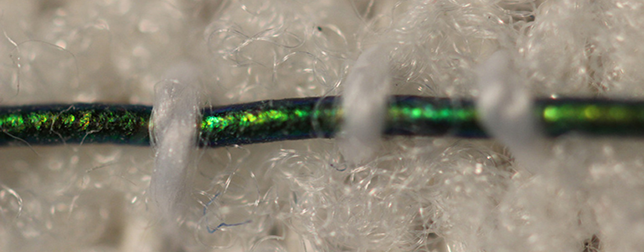MIT engineers have created stretchable photonic fibers that change color in reaction to pressure. The researchers believe this invention could lead to production of color-changing bandages that allow healthcare professionals to easily recognize if the bandage is tight enough or too tight.
People suffering from venous ulcers and blood pressure disorders need compression bandages to be wrapped in their limb in order to stimulate blood flow. However, it is very important that the right amount of pressure is applied. If the bandage isn’t tight enough, the blood won’t return adequately enough and if it’s too tight, the blood flow gets restricted.
Read more Smart Fiber to Introduce Diagnostic Capabilities Into Clothing
“Getting the pressure right is critical in treating many medical conditions including venous ulcers, which affect several hundred thousand patients in the U.S. each year,” said lead researcher of the study Mathias Kolle.
The structure of these pressure-sensitive bandages is same as the ones used by patients all over the globe. Strands of color-changing photonic fibers were added to the bandages, allowing a patient or caregiver to stretch the wrap around a limb, paying attention to the changing color of the fibers to reach the appropriate compression for a specific disease or use case.
Each fiber is about 10 times the diameter of a human hair. This jellyroll-like fiber was created by rolling ultrathin layers of transparent rubber around an elastic core filament. Hundreds of these layers are rolled up lengthwise in each fiber. They change color because of the internal structure, which changes with the stress of the fiber. Light reflects off the inner surface of individual layers to produce the colors that indicate pressure.
Read more Yarn Battery Could Power Smart Clothes and Wearables
A color chart created by the researchers shows how much pressure the wrap exerts when the fibers are different colors. Red indicates the fibers aren’t under stress. As they’re stretched, they keep changing color, becoming orange, then green, blue, and violet. Observing the right color, caregivers and patients know to stop tightening the bandage. These wraps also work as a continuous indicator of effectiveness of the bandage. If the wrap becomes loose, the fibers will change color, letting patients know they’re loose so he/she can tighten them. These fibers do not require any power source to operate.
Currently, fibers are expensive due to the high cost of manufacturing in the lab. Though the materials are common and not costly. The team says, with an industrial operation, these pressure-sensitive fibers would become very cheap.













